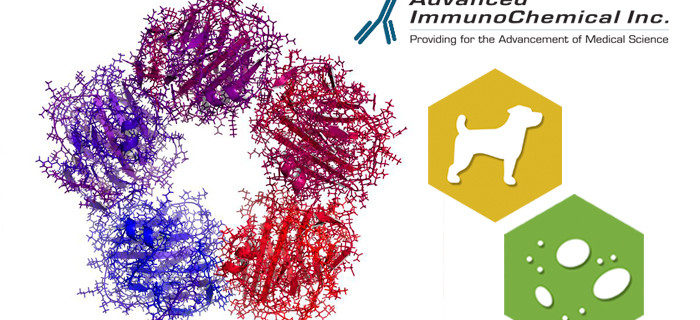Canine C-reactive protein (cCRP) is a major acute phase protein in dogs. Its concentration increases rapidly and significantly during systemic inflammation and subsequently decreases quickly following the elimination of the source of inflammation.
Several studies support the view that cCRP is a valuable diagnostic marker for the detection of the acute phase response in dogs. Its concentration has been shown to increase rapidly in various disorders including viral and bacterial infections, sepsis and pyometra, as well as in surgical trauma. Measuring cCRP from serum can be used in routine canine medicine (1-3 and references therein).
CRP belongs to a family of pentraxins. These evolutionally conserved proteins are pentamers and have calcium-dependent ligand binding properties. CRP is composed of five identical subunits that form a ring-like structure.
Capture – Detection Antibody Pair Recomendations:
The most sensitive antibody pairs are shown in the table below. These recommendations were based on results obtained using the DELFIA® immunoassay platform. Antibodies can perform differently depending on the assay platform and reaction conditions. Therefore, the best antibody combinations should always be validated separately for each assay.
Sandwich Immunoassay for cCRP Detection:
Three of our four MAbs can be used in sandwich immunoassays. The recommended MAb combinations show high sensitivity (up to 0.1 ng/ml) and a long linearity range in a sandwich fluoroimmunoassay. Figure 1. shows a calibration curve for native cCRP using monoclonal antibodies to cCRP11 and cCRP1 for capture and detection respectively.
Figure 1. Calibration curve of native cCRP in a sandwich fluoroimmunoassay. ( cCRP11 -capture antibody – Eu3+–cCRP1-detection antibody ).
Detection of cCRP in Serum Samples:
MAbs were tested for their ability to detect endogenous cCRP in serum samples by measuring cCRP concentrations from serum samples from dogs with systemic inflammation of different origins and serum samples from healthy dogs. Most MAb combinations were able to detect endogenous cCRP in a reliable manner. Figure 2 shows an example of measuring cCRP concentrations using cCRP34 and cCRP1 as capture and detection antibodies respectively. Serum samples from 34 dogs with an inflammation and from 8 healthy dogs were measured. The results demonstrate that the concentration of cCRP in the group of animals with inflammation is considerably higher compared to healthy dogs.
Figure 2. cCRP levels in serum of healthy dogs or dogs with systemic inflammation. cCRP34 and Eu3+-labeled cCRP 1 were used as capture and detection MAbs respectively.
Recombinant cCRP is partially glycosylated:
Our recombinant cCRP is produced in a eukaryotic expression system that allows for the glycosylation of the protein. The purified protein was run in SDS-PAGE under reducing conditions and migrated as two separate bands, similarly to the native cCRP (see Figure 3). The faster migrating bands (b) represent the non-glycosylated subunits. The bands migrating more slowly (a) represent the glycosylated subunits. The differences in their migration indicates that the glycosylation patterns are not identical. However, this does not affect the immunochemical properties of the recombinant cCRP.
Figure 3. Comparison of recombinant and native cCRP in SDS-PAGE. 3 μg of purified proteins were run in 12.5% gel under reducing conditions. The gel was stained with Coomassie brilliant blue R-250. a: glycosylated CRP b: non-glycosylated CRP
Canine CRP Monoclonal Antibody Product
Cat. #2-CRP-c. Monoclonal Mouse Anti-Canine C-reactive Protein (cCRP).
Canine CRP Antigen Product
Cat. #7-CRP-c. Recombinant Canine C-reactive Protein (cCRP).
New! See the Recorded Talk by Prof. David Eckersall: Canine CRP and Other Acute Phase Proteins as Markers of Inflammation.
References:
1. Kjellgaard-Hansen, M. Canine C-reactive protein – a study on the applicability of canine serum C-reactive protein. Ph.D. Thesis. 2004, The Royal Veterinary and Agricultural University, Denmark.
2. Cerón J.J., Eckersall P.D. and Martýnez-Subiela S. Acute phase proteins in dogs and cats: current knowledge and future perspectives. Vet. Clin. Pathol. 2005 Jun; 34(2):85-99.
3. Eckersall P.D. and Bell R. Acute phase proteins: Biomarkers of infection and inflammation in veterinary medicine. Vet. J. 2010, 185:23-27.
Related information:
AssayNotes: Canine C-reactive Protein (cCRP).





